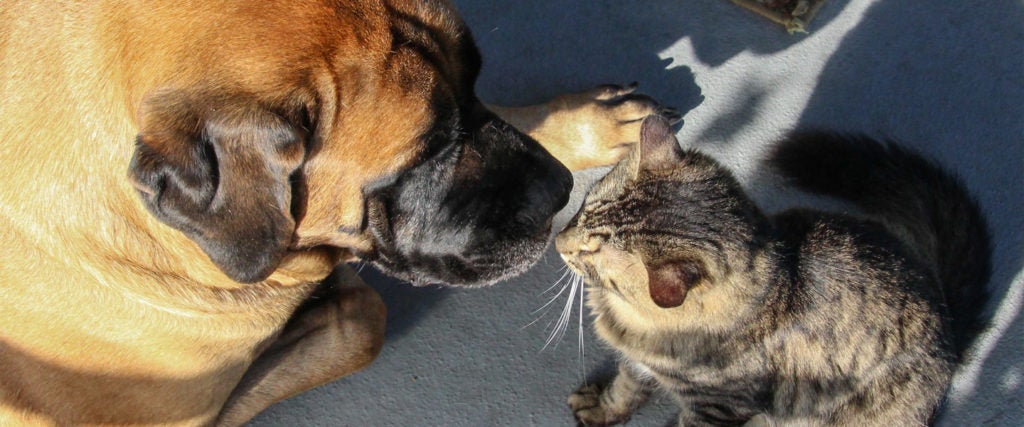Despite what old-school cartoons suggest, dogs and cats can become BFFs.
cat : i suppose that you can join me
(Lisa Plummer) pic.twitter.com/DDilM6sHU9— Humor And Animals (@humorandanimals) March 4, 2020
But unless a puppy and kitten are raised together and learn straight away to tolerate one another, you need to mediate their early interactions and take certain precautions if you expect them to get along. Here are some tips.
Summon Your Inner Matchmaker
Even though cats and dogs can get along, remember that each dog and each cat is an individual, and some may simply prefer living alone. If you want to get a cat for your dog or a dog for your cat, think hard about how their personalities will jell. If your dog likes playing and chasing things, a bashful cat that runs away from literally everything could trigger your pup. In that case, a better choice would be a playful cat confident enough to stand up for themself. Likewise, if your dog is laid back, a calm cat would be a good match. In some cases — if your dog or cat is especially needy or impulsive — they may be better off without a new roommate.
Give Them Their Own Space
The first step to becoming good housemates is desensitization, and that means confining your new pet to a sanctuary room or area with a secure door and everything they need — a litter box, scratching post, water and food bowls and toys, says Jessica Pierce, bioethicist and author of numerous books about pets. This allows your pets to hear and smell each other without face-to-face contact that could turn dangerous. If the dog obsessively scratches at the door or barks at the cat for several days, you may need to enlist the help of a professional trainer.
Feed Them on Opposite Sides of the Door
By feeding your pets near each other, you can get them to associate one another with their favorite thing: Food. It helps to move their food bowls a little closer to the closed door with each feeding, at least until both pets can eat calmly right next to one another while separated by the door. If either animal refuses to eat while the other is in the house, you may be better off maintaining a one-pet household. Sorry.
Take Things Slow
Once your pets can coolly eat on each side of the door, you can begin face-to-face meetings. But first, there are a few precautions you should take: It helps to have high areas in your home, like furniture or shelving, where your cat can escape your dog if things turn sour, and if you have a tall baby gate, Pierce says to consider putting it in place of the closed door so your pets can view and “get to know” each other before physically meeting.
When your pets seem ready for their meet and greet, keep the dog on a tight leash, bring them to a common area of your home — not a sanctuary room — and allow the cat to come and go as they please. “Let both cat and dog take things at their own pace,” Pierce emphasizes. Reward both animals with treats when they display calm behavior, and if either pet demonstrates aggression, distract them with commands, toys or more treats, and return them to their confinement areas. If either animal remains overly focused on the other or lunges, return to the previous steps, enlist a professional or consider a different match.
Repeat this process daily, and do your best to end each meeting before either pet shows aggression. Forcing things could leave a lasting stain on their relationship.
Finally, Let Them Loose
If your pets appear to be getting along under strict watch, you can allow them loose in a common area together, but continue watching them closely, and keep a leash on your dog so you can grab it if tensions erupt. Maintain access to the sanctuary room, and if your pets have a hostile interaction, return to previous steps before moving forward.
From this point on, continue watching them closely, and confine them to separate areas when no one is home. Only when they get along with each other for a significant amount of time (at least a month) can you begin to let your guard down.
Good luck dealing with double the poop.

